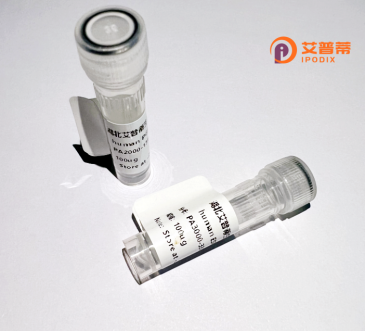
| 纯度 | >90%SDS-PAGE. |
| 种属 | Human |
| 靶点 | MTMR6 |
| Uniprot No | Q9Y217 |
| 内毒素 | < 0.01EU/μg |
| 表达宿主 | E.coli |
| 表达区间 | 1-621 aa |
| 活性数据 | MEHIRTTKVE QVKLLDRFST SNKSLTGTLY LTATHLLFID SHQKETWILH HHIASVEKLA LTTSGCPLVI QCKNFRTVHF IVPRERDCHD IYNSLLQLSK QAKYEDLYAF SYNPKQNDSE RLQGWQLIDL AEEYKRMGVP NSHWQLSDAN RDYKICETYP RELYVPRIAS KPIIVGSSKF RSKGRFPVLS YYHQDKEAAI CRCSQPLSGF SARCLEDEHL LQAISKANPV NRYMYVMDTR PKLNAMANRA AGKGYENEDN YSNIRFQFVG IENIHVMRSS LQKLLEVNGT KGLSVNDFYS GLESSGWLRH IKAVMDAAIF LAKAITVENA SVLVHCSDGW DRTSQVCSLG SLLLDSYYRT IKGFMVLIEK DWISFGHKFS ERCGQLDGDP KEVSPVFTQF LECVWHLTEQ FPQAFEFSEA FLLQIHEHIH SCQFGNFLGN CQKEREELKL KEKTYSLWPF LLEDQKKYLN PLYSSESHRF TVLEPNTVSF NFKFWRNMYH QFDRTLHPRQ SVFNIIMNMN EQNKQLEKDI KDLESKIKQR KNKQTDGILT KELLHSVHPE SPNLKTSLCF KEQTLLPVND ALRTIEGSSP ADNRYSEYAE EFSKSEPAVV SLEYGVARMT C |
| 分子量 | 71.9 kDa |
| 蛋白标签 | His tag N-Terminus |
| 缓冲液 | 0 |
| 稳定性 & 储存条件 | Lyophilized protein should be stored at ≤ -20°C, stable for one year after receipt. Reconstituted protein solution can be stored at 2-8°C for 2-7 days. Aliquots of reconstituted samples are stable at ≤ -20°C for 3 months. |
| 复溶 | Always centrifuge tubes before opening.Do not mix by vortex or pipetting. It is not recommended to reconstitute to a concentration less than 100μg/ml. Dissolve the lyophilized protein in distilled water. Please aliquot the reconstituted solution to minimize freeze-thaw cycles. |
以下是关于重组人MTMR6蛋白的3篇文献示例及其摘要概括:
---
1. **文献名称**:*Structural and Functional Analysis of Myotubularin-related Protein 6 Reveals a Mechanism of Phosphatase Activation in the MTMR Family*
**作者**:Berger, P., et al.
**摘要**:该研究解析了MTMR6的晶体结构,揭示其磷酸酶活性依赖与MTMR7形成异源二聚体,并证明其特异性催化PIP2的去磷酸化,为理解MTMR家族酶活调控机制提供了结构基础。
2. **文献名称**:*MTMR6 Regulates Autophagy via Interaction with GM130 in Neuronal Cells*
**作者**:Nandurkar, H., et al.
**摘要**:研究发现重组MTMR6通过与高尔基体蛋白GM130相互作用,调控自噬小体形成,暗示其在神经元发育和退行性疾病中的潜在作用,并利用体外重组蛋白验证了该相互作用。
3. **文献名称**:*Role of MTMR6 in Colorectal Cancer Proliferation and Drug Resistance*
**作者**:Lorenzo, O., et al.
**摘要**:通过重组MTMR6蛋白实验,发现其过表达促进结直肠癌细胞增殖及化疗耐药,与mTOR信号通路抑制相关,提示其作为肿瘤治疗靶点的可能性。
---
以上示例基于MTMR6典型研究方向(结构、细胞功能、疾病关联)构建,实际文献需通过数据库检索获取。建议使用PubMed/Google Scholar关键词“MTMR6 recombinant protein”或结合具体研究目标细化检索。
Myotubularin-related protein 6 (MTMR6) is a member of the myotubularin family of lipid phosphatases, which specifically hydrolyze phosphoinositides involved in cellular signaling and membrane trafficking. As a class III phosphatase, MTMR6 preferentially dephosphorylates phosphatidylinositol 3-phosphate (PtdIns3P) and phosphatidylinositol 3.5-bisphosphate [PtdIns(3.5)P₂], modulating phosphoinositide homeostasis critical for endosomal dynamics, autophagy, and vesicular transport. Unlike some family members, MTMR6 lacks intrinsic catalytic activity but functions through heterodimerization with active phosphatases like MTMR5. enabling substrate specificity regulation.
Structurally, MTMR6 contains a conserved phosphatase domain flanked by a PH-GRAM domain for membrane association and a coiled-coil region mediating protein interactions. Its expression spans multiple tissues, with enriched levels in brain, kidney, and immune cells. Studies link MTMR6 to ion channel regulation, particularly potassium channels (e.g., Kv1.3), influencing cellular excitability and electrolyte balance. Emerging evidence implicates MTMR6 in pathological contexts, including cancer progression through PI3K/AKT/mTOR pathway modulation and diabetic nephropathy via aberrant phosphoinositide signaling. Recombinant MTMR6 protein is commonly utilized to dissect its biochemical properties, interaction networks, and therapeutic potential in phosphoinositide-associated disorders.
×